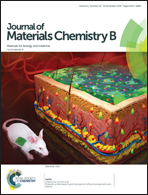Polycaprolactone nanofibers functionalized with placental derived extracellular matrix for stimulating wound healing activity†
Abstract
Impaired wound healing is primarily associated with inadequate angiogenesis, repressed cell migration, deficient synthesis of extracellular matrix (ECM) component/growth factors, and altered inflammatory responses in the wound bed environment. Herein, we report a simple process for the fabrication of PCL nanofiber mats embedded with placental-derived bioactive molecules (PCL–sPEM) rich in growth factors for full-thickness cutaneous wound healing. The physicochemical attributes and biological composition of PCL–sPEM nanofiber mats delivered a nontoxic environment in vitro and significantly promoted the adhesion, infiltration, and proliferation of human fibroblasts/keratinocytes. Conditioned media extracted from PCL–sPEM nanofiber mats enhanced the migration potential of the cells (fibroblasts/keratinocytes) involved in wound healing due to the release of growth factors embedded in it. Further, PCL–sPEM nanofiber mats attracted, stimulated and supported vascularization as determined by the Chick Chorioallantoic Membrane (CAM) assay. Interestingly, critical skin wounds of rats treated with PCL–sPEM nanofiber mats facilitated improved wound closure with well-organized dermis and epidermis, which could be ascribed to prominent vascularization, augmented migration of human foreskin fibroblasts (HFFs) & human epidermal keratinocytes (HEKs), increased collagen synthesis and early re-epithelialization. Collectively, our results suggest that PCL–sPEM nanofiber mats embedded with growth factors could be a suitable matrix for treating critical full-thickness wounds.



 Please wait while we load your content...
Please wait while we load your content...